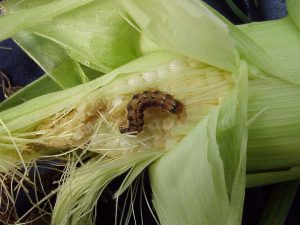Sweet Corn IPM Newsletter No. 8 — August 18, 2023
CORN EARWORM PRESSURE HIGH
Silking Corn Requires Protection at Most Sites

SITUATION
We’ve had another week with some heavy rain showers, making pest management in corn fields challenging. There are some reports of light infestations of caterpillars in ears, despite regular sprays, which may be due to poor efficacy because of sprayed materials washing off or being diluted. Additionally, we are getting reports of poor performance with some of the synthetic pyrethroids, such as Warrior® and Asana®, which may suggest some resistance. Rotate or tank mix different insecticide chemistries to manage and prevent resistance. Effective products with alternative chemistries include Lannate®, Coragen®, Besiege®, Delegate® and Intrepid®.
European corn borer: All fields scouted this week were under threshold for larval feeding in pre-tassel corn. Moth counts also remained low at all sites except Dayton. This suggests that the first generation of European corn borer is over, but a partial second generation may be starting in southern Maine.
Corn earworm: Moth counts were higher in nearly all locations this week. Only a couple of locations caught few or no moths. Based on this week’s moth counts, a 4-day spray interval for silking corn was recommended for Auburn, Biddeford, Cape Elizabeth, Dayton, Farmington, Lewiston, Monmouth, New Gloucester, Oxford and Wells. A 5-day spray schedule was recommended for Garland and Wayne. A 6-day spray interval was recommended for Palmyra. Pheromone trap catch accuracy is still questionable, due to the variable weather. Consider a more cautious approach to protecting corn by applying at least one protective spray at pre-tassel and another when silks first appear, especially if larvae are present in the field.
Fall armyworm: Moth counts were low at most sites this week, several locations remained over the three-moth threshold for silking corn, including Cape Elizabeth, Monmouth, and one Wells site.
Western Bean Cutworm: Moth numbers were mostly lower in traps this week, but still high enough to warrant protection of any silking corn not on a spray schedule for corn earworm or fall armyworm. In the past, populations of this pest drop off very rapidly toward the end of August, so we may be seeing the start of this decline.
Squash vine borer: Moth counts were under the five moth threshold for pumpkins and squash this week.

Birds, etc.: Blackbirds can cause significant damage to corn, especially when they begin flocking towards the end of the summer. They are especially attracted to fields where corn has been allowed to get over-mature. Deer have also been troublesome this year. For information on wildlife problems and management options, you can call the APHIS office in Augusta at 1-866-487-3297.
Sincerely,
David T. Handley
Vegetable & Small Fruit Specialist
Highmoor Farm
P.O. Box 179
52 U.S. Route 202
Monmouth, ME 04259
207.933.2100
UMaine Extension Diagnostic Research Lab
Pest Management Unit
17 Godfrey Drive
Orono, ME 04473
1.800.287.0279
| Location | CEW Moths | ECB Moths | FAW Moths | %Feeding Damage | Recommendations / Comments |
|---|---|---|---|---|---|
| Auburn | 27 | 0 | 0 | — | 4-day interval recommended for silking corn |
| Biddeford | 27 | 0 | 0 | — | 4-day interval recommended for silking corn |
| Bowdoinham | 0 | 2 | 0 | 16% | No spray recommended |
| Cape Elizabeth | 55 | 1 | 5 | — | 4-day interval recommended for silking corn |
| Dayton | 44 | 21 | 0 | — | 4-day interval recommended for silking corn |
| Farmington | 8 | 0 | 0 | — | 4-day interval recommended for silking corn |
| Garland | 6 | 0 | 0 | — | 5-day interval recommended for silking corn |
| Hollis | 1 | 0 | 0 | — | No spray recommended |
| Lewiston | 18 | 0 | 0 | — | 4-day interval recommended for silking corn |
| Monmouth | 13 | 0 | 12 | — | 4-day interval recommended for silking corn |
| New Gloucester | 66 | 0 | 6 | — | 4-day interval recommended for silking corn |
| Oxford | 9 | 0 | 0 | — | 4-day interval recommended for silking corn |
| Palmyra | 2 | 0 | 0 | — | 6-day interval recommended for silking corn |
| Wayne | 4 | 0 | 1 | — | 5-day interval recommended for silking corn |
| Wells I | 10 | 0 | 0 | — | 4-day interval recommended for silking corn |
| Wells II | 14 | 1 | 4 | — | 4-day interval recommended for silking corn |
CEW: Corn earworm (Only fresh silking corn should be sprayed for this insect.)
ECB: European corn borer
FAW: Fall armyworm
| Moths caught per week | Moths caught per night | Spray Interval |
|---|---|---|
| 0.0 to 1.4 | 0.0 to 0.2 | No spray |
| 1.5 to 3.5 | 0.3 to 0.5 | Spray every 6 days |
| 3.6 to 7.0 | 0.6 to 1.0 | Spray every 5 days |
| 7.1 to 91 | 1.1 to 13.0 | Spray every 4 days |
| More than 91 | More than 13 | Spray every 3 days |
Thresholds apply only to corn with exposed fresh silk. Lengthen spray intervals by one day if maximum daily temperature is less than 80°F.
European Corn Borer Thresholds
Whorl stage: 30% or more of plants scouted show injury.
Pre-tassel-silk: 15% or more of plants scouted show injury.
Silk: 5 or more moths caught in pheromone traps in one week.
IPM Web Pages:
Explore Integrated Pest Management in Maine — UMaine
Integrated Pest Management Data Visualization Tool — Penn State
Integrated Pest Management — UMass Amherst
Where brand names or company names are used, it is for the reader’s information. No endorsement is implied nor is any discrimination intended against other products with similar ingredients. Always consult product labels for rates, application instructions and safety precautions. Users of these products assume all associated risks.
In complying with the letter and spirit of applicable laws and pursuing its own goals of diversity, the University of Maine System does not discriminate on the grounds of race, color, religion, sex, sexual orientation, transgender status, gender, gender identity or expression, ethnicity, national origin, citizenship status, familial status, ancestry, age, disability physical or mental, genetic information, or veterans or military status in employment, education, and all other programs and activities. The University provides reasonable accommodations to qualified individuals with disabilities upon request. The following person has been designated to handle inquiries regarding non-discrimination policies: Director of Equal Opportunity, 5713 Chadbourne Hall, Room 412, University of Maine, Orono, ME 04469-5713, 207.581.1226, TTY 711 (Maine Relay System).
